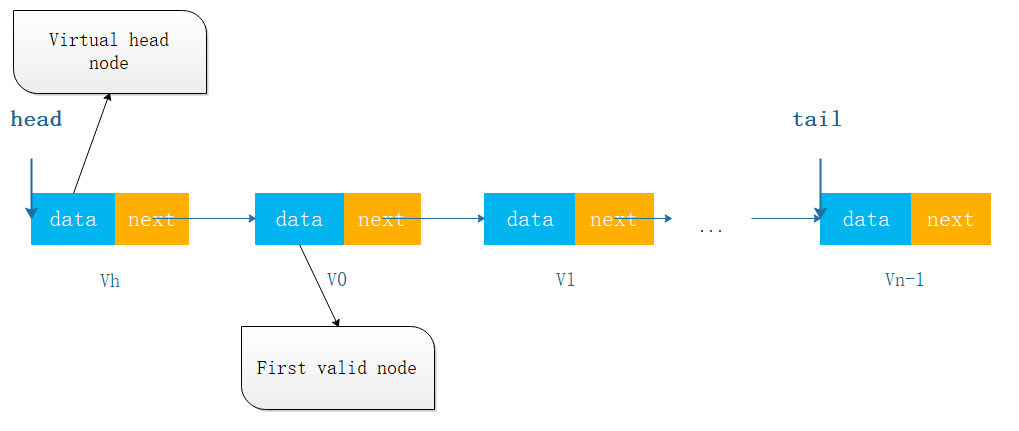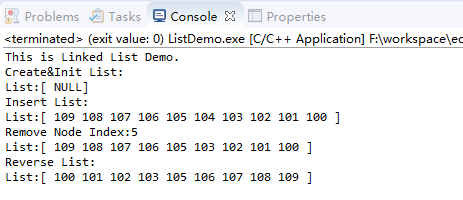单链表 C++ 实现 - 含虚拟头节点
本文例程下载链接:ListDemo
链表 vs 数组
链表和数组的最大区别在于链表不支持随机访问,不能像数组那样对任意一个(索引)位置的元素进行访问,而需要从头节点开始,一个一个往后访问直到查找到目标位置。
单链表
与顺序表相对,链表是一种链式存储方式。单链表是实现顺序表最简单的一种链表,根据是否包含虚拟头节点,分为含虚拟头节点和不含虚拟头节点两种方式。本文以含虚拟头节点为例,用C++实现单链表数据结构ADT。
节点:链表的组成元素,每个节点包含数据域data和指针域next。例程为了简化设计,data用int类型表示。
虚拟头节点:链表的第一个节点,为了维护链表操作方便,但不存放数据。
虚拟头节点(dummy head) VS 无虚拟头节点
含虚拟头节点的链表优势:所有的数据节点(除去头节点)都是对等的,对链表节点的API操作一般不影响头节点本身指针变化(除去头节点next域)。
缺点:需要额外考虑头节点影响,比如IsEmpty()判断条件, 和Length()是否对等(IsEmpty <=> length==0?),头节点对用户是否可见,能否被用户直接remove等。
单链表结构设计
含虚拟头节点的单链表list如下图所示,包含一个虚拟头节点V0,而V1~Vn通过前驱节点next域进行链接,从而形成一个单向链式结构。
虚拟头节点V0,不包含数据;V1~Vn包含数据,Vn->next = NULL
| 名称 | 描述 | 代表自定义符号 |
| 虚拟头节点 | 不包含数据 | Vh/head |
| 尾节点 | 链表的最后一个节点,特征:next=NULL | Vn-1/tail |
| 普通数据节点 | 包含具有实际意义数据的节点 | V0~Vn-1 |
| 长度 | 包含实际意义数据节点数为n(不包括Vh) | length |
| 空链表 | 虚拟头节点为空,即head=NULL | V0=NULL |
| 位置 |
从V0开始(Vh后继节点)开始计数0,直到Vn-1(尾节点)的节点对应位置。范围[0,n-1] |
position |
| 插入节点 | 在指定位置处插入节点,除插入节点及前驱和后继,不改变链表其他节点关系 | insert |
| 删除节点 | 在指定位置处删除节点, 除插入节点及前驱和后继,不改变链表其他节点关系 | remove |

单链表ADT设计
1. 链表节点ADT Node.h
/**
* 单链表节点类
*/
class Node
{
int data;
Node *next; public:
Node();
Node(Node*, int);
};
2. 单链表ADT LinkedList.h
/**
* 单链表类
* @description 带虚拟头节点
*/
class LinkedList
{
private:
Node *head;
Node *tail; public:
LinkedList();
virtual ~LinkedList();
Status Init(); // 初始化链表
Status Destroy(); // 销毁链表 int Length(); // 求链表长度(有效节点)节点个数
bool IsEmpty(); // 链表是否为空
Status Insert(int pos, int value); // 在指定位置生产节点, 并插入数据
Status Remove(int pos); // 删除指定位置节点
int GetValue(int pos); // 读取指定位置节点数据
Node* GetAddress(int pos); // 获取知道位置节点的地址
int SearchPosition(int value); // 搜索第一个出现的元素值的节点位置
Status Update(int pos, int value); // 更新指定位置节点数据
Status ClearList(); // 清除链表数据(不包含头节点)
Status PrintList(); // 顺序打印链表节点数据
Status Reverse(); // 反转链表
};
3. Node实现 Node.cpp
#include "Node.h"
#include <cstdlib> Node::Node() {
data = 0;
next = NULL;
} Node::Node(Node* newNext, int newValue)
{
data = newValue;
next = newNext;
} Node::~Node()
{
// TODO Auto-generated destructor stub
}
4. 链表实现LinkedList.cpp
#include "LinkedList.h"
#include <cstdlib>
#include <iostream> using namespace std; LinkedList::LinkedList() {
head = NULL;
tail = NULL;
} LinkedList::~LinkedList() {
Destroy();
} /**
* 初始化链表
*/
Status LinkedList::Init()
{
// 创建虚拟头节点
head = new Node(NULL, 0); if(head != NULL)
{
return OK;
} return ERROR;
} /**
* 销毁链表
* @description 与初始化操作相对, 删除所有链表节点, 包括头节点
*/
Status LinkedList::Destroy()
{
if(head)
{
Node *curP = head; while(head)
{
curP = head->next;
delete head;
head = curP;
} return OK;
}
else
{
cout <<"The list is NULL"<<endl;
return ERROR;
}
} /**
* 求链表长度(有效节点)节点个数
* @description 从虚拟头节点的下一个节点开始计算有效节点数
*/
int LinkedList::Length()
{
if(!head)
{
cout <<"The list is NULL"<<endl;
exit(-1);
} Node *curP = head->next;
int n = 0;
while(curP != NULL)
{
n ++;
curP = curP->next;
} return n;
} /**
* 判断链表是否为空
* @description 判断依据: 虚拟头节点head == NULL
* 注: 长度为0 不代表链表为空
*/
bool LinkedList::IsEmpty()
{
return (head == NULL);
} /**
* 在指定位置生产节点, 并插入数据
* @param pos [in] 待插入位置. 从头节点的后继开始为0计数,所需要经过的节点数。范围:0~n-1
* @param value [in] 待插入节点数据域
*/
Status LinkedList::Insert(int pos, int value)
{
if(IsEmpty())
{
cout <<"The list is NULL. Pls Create an List and init it first."<<endl;
exit(-1);
} // create a new Node
Node *newNode = new Node(NULL, value); if(pos == 0)
{
newNode->next = head->next;
head->next = newNode;
}
else if(pos >0 && pos <= Length())
{
// find the predecessor node to be inserted
Node *p = GetAddress(pos-1); // insert the new Node to List
if(p != NULL)
{
if(p->next != NULL)
{// not tail
newNode->next = p->next;
}
p->next = newNode;
}
}
else
{
cout<<"Error: Input param Pos is illegal(<0)"<<endl;
return ERROR; } return OK;
} /**
* 删除指定位置节点
* @param pos [in] 待插入位置. pos有效范围: [0, n), 0代表虚拟节点后面一个节点, 虚拟节点无法通过此API删除
*
*/
Status LinkedList::Remove(int pos)
{
Node *preNode = NULL;
Node *curNode = NULL;
Node *nextNode = NULL; if(pos < 0 || pos >= Length())
{
cout << "Remove node with error position"<<endl;
exit (-1);
}
else if(pos == 0)
{// find the prior node, namely , head node
preNode = head;
}
else if(pos < this->Length())
{
// find the prior node
preNode = GetAddress(pos - 1);
} if(!preNode)
{
return ERROR;
} curNode = preNode->next;
if(curNode)
{
nextNode = curNode->next;
preNode->next = nextNode;
delete curNode;
} return OK;
} /**
* 读取指定位置节点数据
*/
int LinkedList::GetValue(int pos)
{
// find the node
Node *curP = GetAddress(pos);
if(curP != NULL)
{
return curP->data;
}
else
{
return 0;
}
} /**
* 获取位置节点的地址
* @param pos [in] 从头节点的后继开始为0计数,所需要经过的节点数。范围:[0, n-1], n是链表长度(有效数据节点数)
* @return 节点的地址
*/
Node* LinkedList::GetAddress(int pos)
{
// valid list is null or not
if(!head)
{
cout <<"The list is NULL"<<endl;
exit(-1);
} // valid intput param
if(pos < 0 || pos >= Length())
{
cout <<"Insert position is out of the list's bounds"<<endl;
exit(-1);
} // 顺序查找位置pos的节点
int i = 0;
Node *curP = head->next;
while(curP != NULL)
{
if(i == pos)
{
return curP;
} i ++; curP = curP->next;
} return NULL;
} /**
* 搜索第一个出现的元素值的节点位置
* @param value 待查找值
* @return 链表第一个节点的数据域=value的位置
* - ERROR 错误
* - >=0 位置序号
*/
int LinkedList::SearchPosition(int value)
{
// valid list is null or not
if(!head)
{
cout <<"The list is NULL"<<endl;
exit(-1);
} // sequential search
Node *p = head->next;
int i = 0;
while(p != NULL)
{
i ++;
if(p->data == value)
return i;
else
p = p->next;
} cout<< "Can't find the value in list"<<endl;
return ERROR;
} /**
* 更新指定位置节点数据
* @param pos [in] 待更新节点位置
* @param value [in] 待更新节点要修改的目标值
* @return 更新结果
* - OK 正常更新
* - ERROR 没有找到待更新节点, 可能由位置错误或者链表为空导致
*/
Status LinkedList::Update(int pos, int value)
{
// find the node
Node *curP = GetAddress(pos);
if(curP != NULL)
{
curP->data = value;
return OK;
} return ERROR;
} /**
* 清除链表数据(不包含头节点)
*/
Status LinkedList::ClearList()
{
// valid list is null or not
if(!head)
{
cout <<"The list is NULL"<<endl;
exit(-1);
} Node *p = head->next;
Node *tmp = NULL; while(p!=NULL)
{
tmp = p;
p = p->next;
delete tmp;
} head->next = NULL; return OK;
} /**
* 顺序打印链表节点数据
*/
Status LinkedList::PrintList()
{
// valid list is null or not
if(IsEmpty())
{
cout <<"The list is NULL. Pls Create an List and init it first."<<endl;
return ERROR;
} cout <<"List:[ ";
if(Length() == 0)
{
cout<<"NULL";
}
else
{
Node *p = head->next; while(p != NULL)
{
cout<<p->data<<" ";
p = p->next;
}
}
cout <<"] "<<endl;
return OK;
} /**
* 反转链表, 除虚拟头节点
*/
Status LinkedList::ReverseList()
{
// valid list is null or not
if(IsEmpty())
{
cout <<"The list is NULL. Pls Create an List and init it first."<<endl;
exit(-1);
} if(Length() == 0)
{
cout <<"The list length = 0. Pls insert new Node."<<endl;
exit(-1);
} // reverse List
Node *pre = head->next; // precursor Node
Node *cur = pre->next; // current Node
Node *nxt = NULL; // successor Node while(cur != NULL)
{
nxt = cur->next;
cur->next = pre;
pre = cur;
cur = nxt;
} // set the tail Node
head->next->next = NULL; // set the head Node's next field
head->next = pre; return OK;
}
6. 测试结果
可以看到已经实现了链表基本的插入、打印、反转等功能。

单链表 C++ 实现 - 含虚拟头节点的更多相关文章
- 以K个为一组反转单链表,最后不足K个节点的部分也反转
package StackMin.ReverseList_offer16; public class ReverseKgroup_extend_offer16 { /** * 分组反转单链表,最后不足 ...
- 20140719 找到单链表的倒数第K个节点 判断一个链表是否成为一个环形 反转
1.找到单链表的倒数第K个节点 2.判断一个单链表对否形成环形 3.单链表翻转
- C语言:将带头节点的单向链表结点域中的数据从小到大排序。-求出单向链表结点(不包括头节点)数据域中的最大值。-将M*N的二维数组中的数据,按行依次放入一维数组,
//函数fun功能是将带头节点的单向链表结点域中的数据从小到大排序. //相当于数组的冒泡排序. #include <stdio.h> #include <stdlib.h> ...
- Leetcode24--->Swap Nodes in Pairs(交换单链表中相邻的两个节点)
题目:给定一个单链表,交换两个相邻的节点,且返回交换之后的头节点 举例: Given 1->2->3->4, you should return the list as 2-> ...
- C语言实现单链表(不带头结点)节点的插入
对单链表进行增删改查是最主要的操作.我在上一篇博客<C语言实现链表节点的删除>实现了删除单链表中的某个节点. 这里我们要来实如今某个位置插入节点.演示样例代码上传至https://gith ...
- iOS常用算法之单链表查找倒数第n个节点(图解)
拿到题目, 首先要先了解链表数据结构, 如下图: 常规思路: 利用数组, 遍历整个单链表, 将每个节点装入数组中, 最终拿到数组根据索引(数组长度-1-n)就得到了倒数第n个元素, 这里要注意从数组中 ...
- [LeetCode题解]86. 分隔链表 | 三指针 + 虚拟头节点
解题思路 三指针,一个指向前半部分待插入位置,一个指向后半部分待插入位置,最后一个从前往后遍历 代码 /** * Definition for singly-linked list. * public ...
- 面试题-----求单链表的倒数第k个节点
#include <iostream> using namespace std; struct node{ int value; struct node *next; }; struct ...
- C++获取单链表的倒数第k个节点
/* struct ListNode { int val; struct ListNode *next; ListNode(int x) : val(x), next(NULL) { } };*/ c ...
随机推荐
- Go性能调优
文章引用自 Go性能调优 在计算机性能调试领域里,profiling 是指对应用程序的画像,画像就是应用程序使用 CPU 和内存的情况. Go语言是一个对性能特别看重的语言,因此语言中自带了 pr ...
- Go同步等待组/互斥锁/读写锁
1. 临界资源 package main import ( "fmt" "time" ) func main() { /* 临界资源: */ a := 1 go ...
- 【常见浏览器的UA】
"所谓 UA(User Agent / 用户代理),最初是指浏览器告知网站管理员,本浏览器支持的类型和框架,让网站管理员以支持的模式结构向浏览器发送页面,呈现给用户浏览.演变到今天,网站管理 ...
- 算法刷题--回溯算法与N皇后
所谓回溯算法,在笔者看来就是一种直接地思想----假设需要很多步操作才能求得最终的解,每一步操作又有很多种选择,那么我们就直接选择其中一种并依次深入下去.直到求得最终的结果,或是遇到明细的错误,回溯到 ...
- leetCode练题——7. Reverse Integer
1.题目: 7. Reverse Integer Given a 32-bit signed integer, reverse digits of an integer. Example 1: I ...
- 2019 EIS高校安全运维赛 misc webshell
webshell 第一种思路: 1.菜刀都是http协议,发的包都是POST包,所以在显示过滤器下命令:http.request.method==POST 2.右键,追踪tcp流,发现是蚁剑流量 3. ...
- list-style: none;
表明list项前面没有什么修饰(一片空白).
- 以C语言为例完成简单的网络聊天程序以及关于socket在Linux下系统调用的分析
套接字是网络编程中的一种通信机制,是支持TCP/IP的网络通信的基本操作单元,可以看做是不同主机之间的进程进行双向通信的端点,简单的说就是通信的两方的一种约定,用套接字中的相关函数来完成通信过程. 端 ...
- Ethereum Learning Materials
Home 注:本页为 EthFans 站内文章精选集.鉴于文章的采集范围较广,我们无法保证文章内容没有重复,也不能保证排列的顺序实现了最优的认识路径.我们只能说,这些文章是我们精挑细选后,确认可以长期 ...
- Yii2.0如何建立公共方法
yii2-advanced版本 common 目录为公共资源目录,我们可以把定义的方法放在这个目录下,在此目录下我们随意建立一个文件比如”helps”目录,因为考虑到公共方法可能会有功能上的划分类,所 ...
